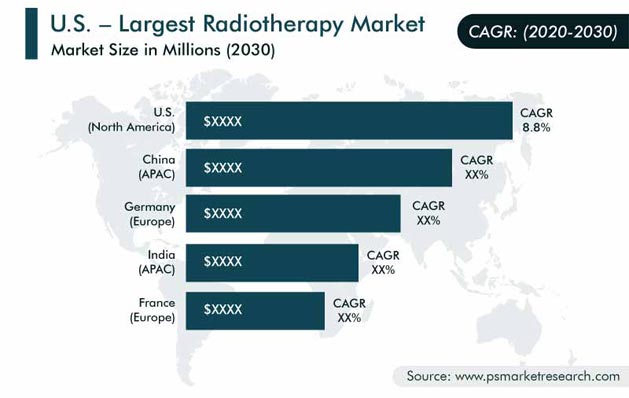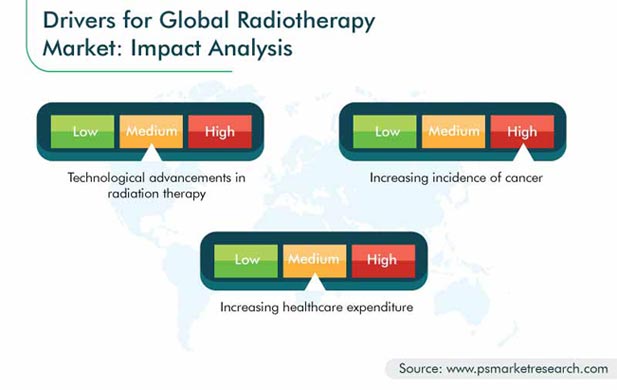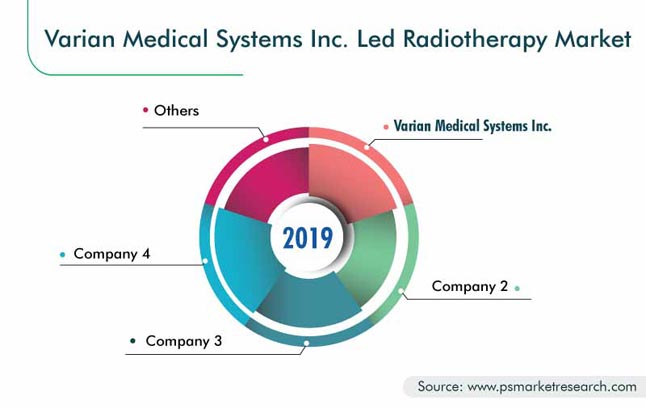Report Code: 12064 | Available Format: PDF | Pages: 246
Radiotherapy Market Research Report: By Type (External Beam, Internal Beam, Systemic), End User (Hospitals, Independent Radiotherapy Centers, Cancer Research Institutes) - Global Industry Analysis and Growth Forecast to 2030
- Report Code: 12064
- Available Format: PDF
- Pages: 246
- Report Description
- Table of Contents
- Market Segmentation
- Request Free Sample
Market Outlook
The radiotherapy market revenue stood at $7,222.4 million in 2019, and it is expected to advance at a CAGR of 8.4% during 2020–2030. The increasing incidence of cancer and rising adoption of advanced treatment procedures are the primary factors supporting the market growth.
The radiotherapy industry suffered a huge setback in the first two quarters of 2020 due to the COVID-19 outbreak. The slowdown in the market can be owed to the lockdowns and non-functional cancer-specialty hospitals and oncology departments at multispecialty hospitals in several countries. Apart from this, the international trade of radiotherapy systems and associated accessories were affected due to limited air transport services, thereby imposing a negative on the market.
However, in present times, various countries are relaxing their lockdowns and most hospitals have resumed cancer surgeries. Owing to these reasons, the number of radiotherapy procedures is now surging, and they are expected to reach an adequate volume to support the market advance in the coming years.

External-Beam Equipment To See Fastest Demand Growth
The external beam category, within the type segment, is expected to register the fastest growth in the coming years. In external-beam radiation therapy high-energy X-ray radiation is delivered to tumors within the patient’s body by a machine outside it.
Hospitals Largest and Fastest-Growing Category
In the radiotherapy market, the hospitals category of the end user segment generated the highest revenue in 2019. This is because most of the radiotherapy procedures are done at hospitals, under the supervision of trained healthcare professionals, owing to their complexity. These healthcare settings are the initial point of contact for the diagnosis and treatment of illnesses because they offer the best-possible service, which is why this category will witness the highest CAGR till 2030.
North America Dominates Market
The North American market for radiotherapy systems generated the highest revenue in 2019, and it is expected to continue its dominance in the near future. The region is led by the U.S. due to the wide installation of radiotherapy equipment in the country. Additionally, the presence of an umpteen number of private research institutes and healthcare providers that are heavily deploying radiotherapy systems is supporting the market growth, as is its huge healthcare expenditure. According to the World Bank Group, healthcare spending in the U.S. surged from 16.5% of its gross domestic product (GDP) in 2014 to 17.1% in 2017. Similarly, in Canada, healthcare expenditure rose from 10.1% of its GDP in 2014 to 10.6% in 2017.
Asia-Pacific (APAC) To Record Fastest Growth
The APAC radiotherapy market is expected witness the fastest growth between 2020 and 2030. The key factors supporting this growth include the surging burden of cancer, spurring investments by private and public organizations, and improving healthcare infrastructure. For example, the Global Cancer Observatory (GLOBOCAN) data reflects that Japan recorded 883,395 cancer cases in 2018, and the number is estimated to reach 3.5 million by 2025.

Innovations in Radiotherapy Are Key Market Trends
Recent innovations in the radiotherapy domain have enhanced the effectiveness of treatments, thereby resulting in reduced side-effects and improved outcomes. Notable developments are being observed in the fields of particle therapy, intensity-modulated radiation therapy (IMRT), 4D imaging, nanotechnology, and stereotactic body radiation therapy (SBRT). One of the major developments is the advent of the adaptive radiation therapy (ART) treatment, which can be adjusted to improve the patient outcomes, because the characteristics of tumors and patients change throughout the treatment course.

Rising Technological Developments Accelerating Market Growth
Technological advancements in treatment protocols have fueled the demand for automated products, which can be incorporated into clinical practice systems to reduce the time and increase the effectiveness of treatments. Owing to these developments, the radiotherapy market will register positive growth in the future. With technological advancements, there has been an extensive focus on the improvement of patient care. Additionally, the availability of more-efficient, automated, and advanced clinical tools in radiation therapy and advent of more-precise forms of radiotherapy, including IMRT, SBRT, image-guided radiation therapy (IGRT), volumetric-modulated arc therapy (VMAT), stereotactic radiosurgery (SRS), proton therapy, and brachytherapy, are significantly contributing to the growth of the market for radiotherapy equipment.
Surging Cancer Cases To Increase Market Size
The soaring burden of chronic diseases is affecting low- and middle-income countries (LMICs), as well as high-income countries. For instance, cancer is one of the most-prevalent chronic illnesses in the world. According to the American Institute of Cancer Research, by 2030, the number of new cancer cases will reach around 25 million. Most of these cases will be recorded in LMICs, such as India and China. Additionally, according to the World Health Organization (WHO), cancer was responsible for 9.6 million deaths in 2018, with LMICs reporting 70% of the deaths. This number can be lowered if proper medical care is offered at the initial stages, which can be accomplished by radiotherapy and chemotherapy.
| Report Attribute | Details |
Historical Years |
2014-2019 |
Forecast Years |
2020-2030 |
Base Year (2019) Market Size |
$7,222.4 million |
Forecast Period CAGR |
8.4% |
Report Coverage |
Market Trends, Revenue Estimation and Forecast, Segmentation Analysis, Regional and Country Breakdown, Competitive Analysis, Companies’ Strategic Developments, Product Benchmarking, Company Profiling |
Market Size by Segments |
Type, End User, Geography |
Market Size of Geographies |
U.S., Canada, Germany, U.K., France, Italy, Spain, Japan, China, India, Indonesia, Australia, Brazil, Mexico, Saudi Arabia, South Africa |
Secondary Sources and References (Partial List) |
German Cancer Research Center, Hong Kong Sanatorium & Hospital, Institute for Health Metrics and Evaluation, Instituto Mexicano Del Seguro Social, International Agency for Research on Cancer, International Atomic Energy Agency, International Medical Device Regulators Forum, Japanese Cancer Association, Korean Cancer Association, Union for International Cancer Control |
Explore more about this report - Request free sample
Market Players Launching New Products and Services to Gain Competitive Edge
The global radiotherapy market is fragmented in nature, with the presence of several key players, such as Varian Medical Systems Inc., Elekta AB, and Accuray Incorporated.
In recent years, major players in the radiotherapy industry have taken several strategic measures, such as product launches, partnerships, and acquisitions, to gain a competitive edge in the market.
- In April 2020, Elekta AB announced the launch of Geneva, a universal gynecological applicator, for brachytherapy. The adaptable product can accommodate most female pelvic anatomies.
- In April 2020, ViewRay Inc. entered into a strategic collaboration with VieCure, an AI informatics company. Through this alliance, clinicians will have access to ViewRay’s MRIdian magnetic resonance imaging (MRI)-guided radiation therapy system and VieCure’s VCurePrecision electronic medical record (EMR) platform.
- In May 2019, Varian Medical Systems Inc. acquired CyberHeart, a privately held company which developed the technology to use radiation therapy for cardiovascular diseases. The acquisition of CyberHeart has opened ways for Varian Medical Systems Inc. to expand its focus on the cardiac radioablation space.
The Key Players in Radiotherapy Market include:
-
Elekta AB
-
Accuray Incorporated
-
Hitachi Ltd.
-
Becton, Dickinson and Company
-
Ion Beam Applications SA
-
Isoray Inc.
-
Provision Healthcare
-
Sumitomo Heavy Industries Ltd.
-
Varian Medical Systems Inc.
-
ViewRay Inc.
-
Mevion Medical Systems Inc.
-
Optivus Proton Therapy Inc.
-
Panacea Medical Technologies Pvt. Ltd.
-
P-Cure Ltd.
Radiotherapy Market Size Breakdown by Segment
The radiotherapy market report offers comprehensive market segmentation analysis along with market estimation for the period 2014–2030.
Based on Type
- External Beam
- By product
- Linear accelerators (LINACs)
- Particle/proton therapy systems
- Conventional cobalt-60 teletherapy systems
- By technology
- Stereotactic therapy
- Image-guided
- Intensity-modulated
- Particle beam therapy
- 3D conformal
- By product
- Internal Beam
- By product
- Seeds
- Electronic brachytherapy systems
- Afterloaders
- Applicators
- By technology
- High-dose rate (HDR)
- Low-dose rate (LDR)
- Pulsed-dose rate (PDR)
- By product
- Systemic
Based on End User
- Hospitals
- Independent Radiotherapy Centers
- Cancer Research Institutes
Geographical Analysis
- North America
- U.S.
- Canada
- Europe
- Germany
- France
- Italy
- Spain
- U.K.
- APAC
- China
- Japan
- India
- Australia
- Indonesia
- LATAM
- Brazil
- Mexico
- MEA
- Saudi Arabia
- South Africa
The sales of radiotherapy systems are expected to generate $17,194.4 million in 2030, progressing with a CAGR of 8.4% during 2020–2030.
The increasing prevalence of cancer, improved healthcare infrastructure, and presence of giant players are some of the major factors contributing to the growth of the radiotherapy market in the U.S.
Cancer cases require advanced treatment procedures, including radiation therapy, in their various stages which is ultimately leading to the rising requirement for radiotherapy systems.
Varian Medical Systems Inc., followed by Elekta AB and Accuray Incorporated, leads the global radiotherapy market.
Want a report tailored exactly to your business strategy?
Request CustomizationWant an insight-rich discussion with the report author?
Speak to AnalystOur dedication to providing the most-accurate market information has earned us verification by Dun & Bradstreet (D&B). We strive for quality checking of the highest level to enable data-driven decision making for you
Our insights into the minutest levels of the markets, including the latest trends and competitive landscape, give you all the answers you need to take your business to new heights
With 24/7 research support, we ensure that the wheels of your business never stop turning. Don’t let time stand in your way. Get all your queries answered with a simple phone call or email, as and when required
We take a cautious approach to protecting your personal and confidential information. Trust is the strongest bond that connects us and our clients, and trust we build by complying with all international and domestic data protection and privacy laws
